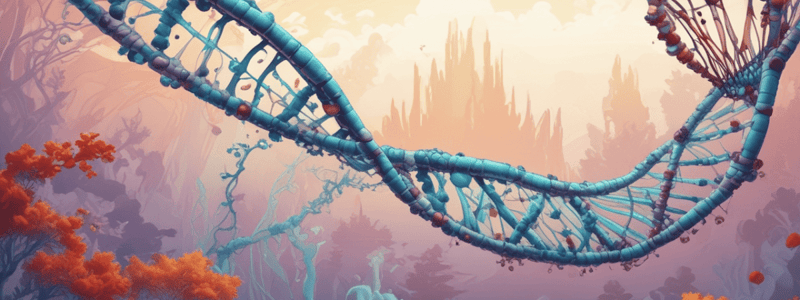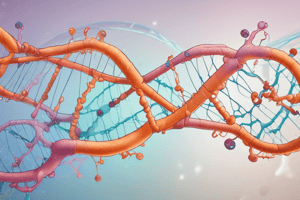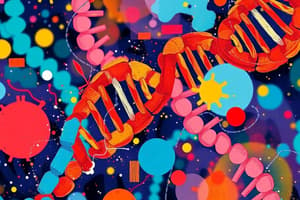Podcast
Questions and Answers
What is the primary function of alternative splicing in gene expression?
What is the primary function of alternative splicing in gene expression?
- To regulate RNA localization in the cell
- To generate multiple protein isoforms with distinct functions (correct)
- To introduce mutations in the RNA molecule
- To repair damaged RNA molecules
What type of modification occurs during RNA editing?
What type of modification occurs during RNA editing?
- Phosphorylation of specific nucleotides
- Deamination of specific nucleotides (correct)
- Methylation of specific nucleotides
- Hydrolysis of specific nucleotides
What is the primary mechanism of mRNA localization?
What is the primary mechanism of mRNA localization?
- Degradation of RNA molecules in specific subcellular regions
- Recognition of specific sequence elements by RNA-binding proteins (correct)
- Transport of RNA molecules through the endoplasmic reticulum
- Synthesis of RNA molecules in specific subcellular regions
What is the primary function of the spliceosome?
What is the primary function of the spliceosome?
What is the name of the enzyme involved in RNA editing that converts adenosine to inosine?
What is the name of the enzyme involved in RNA editing that converts adenosine to inosine?
What is the primary mechanism of RNA transport?
What is the primary mechanism of RNA transport?
Flashcards are hidden until you start studying
Study Notes
RNA Splicing
Alternative Splicing
- A process that generates multiple mRNA isoforms from a single gene
- Involves the selection of different exons or exon segments to include in the final mRNA transcript
- Can result in different protein isoforms with distinct functions or localization
- Regulated by various factors, including:
- Splicing factors (e.g. SR proteins, hnRNP proteins)
- Chromatin modifications (e.g. histone modifications)
- Transcriptional co-regulators (e.g. mediator complex)
RNA Editing
- A post-transcriptional modification that alters the nucleotide sequence of RNA
- Involves the deamination of specific nucleotides (e.g. A-to-I editing)
- Can affect the coding sequence, splicing patterns, or stability of the RNA molecule
- Enzymes involved: ADAR (adenosine deaminase acting on RNA) and APOBEC (apolipoprotein B mRNA editing enzyme, catalytic polypeptide-like)
mRNA Localization
- The process of targeting mRNA molecules to specific subcellular regions or organelles
- Involves the recognition of specific sequence elements (e.g. zip codes, localization elements) by RNA-binding proteins
- Regulated by various factors, including:
- RNA-binding proteins (e.g. zipcode-binding protein 1)
- Microtubules and microfilaments (cytoskeleton)
- Signaling pathways (e.g. MAPK, mTOR)
RNA Transport
- The process of transporting RNA molecules from the nucleus to the cytoplasm
- Involves the recognition of specific sequence elements (e.g. nuclear export signals) by RNA-binding proteins
- Regulated by various factors, including:
- Nuclear pore complexes
- RNA-binding proteins (e.g. NXF1, Aly/REF)
- Signaling pathways (e.g. CRM1, RanGTP)
Spliceosome
- A large ribonucleoprotein complex that catalyzes the removal of introns and joining of exons
- Composed of five small nuclear RNAs (snRNAs) and over 100 proteins
- The spliceosome recognizes specific sequence elements (e.g. splice sites, branch points) and catalyzes the splicing reaction
- Regulated by various factors, including:
- Splicing factors (e.g. U1, U2, U4, U5, U6)
- Chromatin modifications (e.g. histone modifications)
- Transcriptional co-regulators (e.g. mediator complex)
Studying That Suits You
Use AI to generate personalized quizzes and flashcards to suit your learning preferences.




